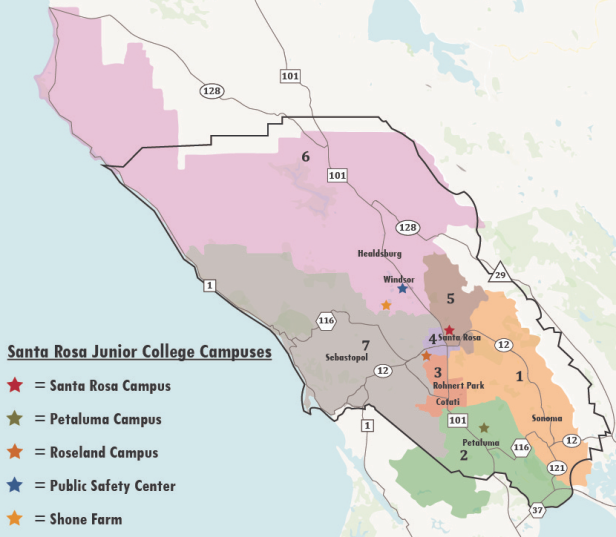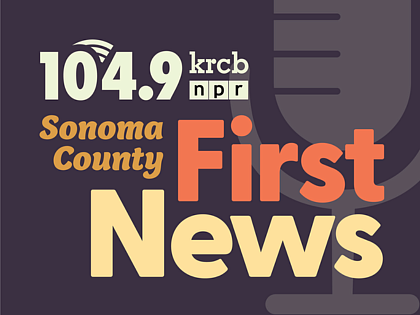 photo credit: Courtesy of SCJCD
photo credit: Courtesy of SCJCDA map of the Sonoma County Junior College District.
The Sonoma County Junior College District is looking to raise over $900 million dollars to pay for upgrades and maintenance at Santa Rosa Junior College and the district’s campuses across Sonoma County.
To learn more, KRCB's Greta Mart speaks with Press Democrat reporter Paulina Pineda about her recent reporting on what could be Sonoma County’s largest-ever school-related bond measure.
We started by asking Pineda what’s on the table, and why:
PAULINE PINEDA: Santa Rosa Junior College is looking at the potential for a general obligation bond in 2026 to help address maintenance needs at its campuses, as well as upgrades that school officials have said will help meet the demands of future students, as well as the demands of the employment sector across Sonoma County. They're considering a couple of different options.
GRETA MART: And what are the options?
PINEDA: Financial consultants presented to the board of trustees back in May different bond options that would allow them to tap up to $952 million in bond revenue. Some of the options included authorizing up to a new $25 per $100,000 of assessed value bond.
MART: Okay. And these are property owners only in Santa Rosa, or is this countywide?
PINEDA: So the district stretches beyond the county into a little bit of Mendocino, Napa, and even Marin County, but the bulk of taxpayers are in Sonoma County. And these types of bonds are paid through property taxes. So if you're a property owner and you live within the college district, a part of your property taxes would go toward repaying these bonds.
MART: Have they done any kind of polling? Do they have any idea of what the voters feel about this proposition?
PINEDA: They haven't done polling yet, but that's something they'll look to do probably later this year or even early next year before making a final decision, both on whether it's feasible to pursue a bond in the first place, and then also the size of the bond. I think part of what they're hoping to gauge is just how much voters and taxpayers in the district are going to be willing to support. This would be the largest school-related bond in county history, and about potentially twice the size of the last bond that was approved for the college back in 2014, which was $410 million.
MART: Let's talk about this…some folks will be like, we already gave you a bunch of money, what happened to it? What’s their answer?
PINEDA: A lot of that funding went to upgrades at the district's main campus on Mendocino Avenue. Students are taking advantage of new science labs, revamped student centers. They made upgrades at some of the performing arts spaces as well as the athletic fields. They expanded the campus in Petaluma, as well as some of their smaller satellite campuses, such as their public safety training site in Windsor, as well as their farm, where students work on agricultural projects out in Forestville. School officials say that all of that money has been allocated, and as they're spending the last bit of it down, they're still seeing needs. After the last bond was approved, they crafted a facilities master plan outlining how that money would be spent, both on infrastructure needs at its campuses, as well as expansions of its campuses. And school officials say, while they've made a lot of progress on that plan, there's still more work to do.
MART: What did you hear from college administrators? What are they telling you? Like Ezra Shaban?
PINEDA: The board president, Ezra Shaban, said that district voters have supported the district at the ballot twice back in 2002 with the first bond, and then in 2014, and that they recognize that money has been spent to really, I think, transform the junior college and the type of programs that it offers to students. And that, despite that growth over the last couple of years, more help is needed. And so he said there's still some unmet needs at the district and that this is one potential way to address those needs and deliver more for the community. But he noted that they're at the very, very, very beginning of this discussion. The board has had just one study session to talk about potentially looking at a bond next year. They authorized staff to hire a consultant to help them with the polling, but he said that this is just the beginning and they're hoping to have additional discussions throughout the year and early next year, and that those discussions will be transparent and that students and voters in the district will have a lot more opportunity to weigh in.
MART: I was going to say, what's next? So if folks are interested in this topic, they should just, what, essentially wait for the consultant to finish their analysis? Is that it?
PINEDA: Yes. So the consultant is likely to take this summer to put together the polling, and then I think the board is likely to have a discussion about next steps, whether that's additional studies or additional polling, or whether they feel confident that they have the support needed to potentially put a ballot measure on either the primary or general ballot next year.
That’s Press Democrat reporter Paulina Pineda speaking with KRCB's Greta Mart.

 Live Radio
Live Radio




